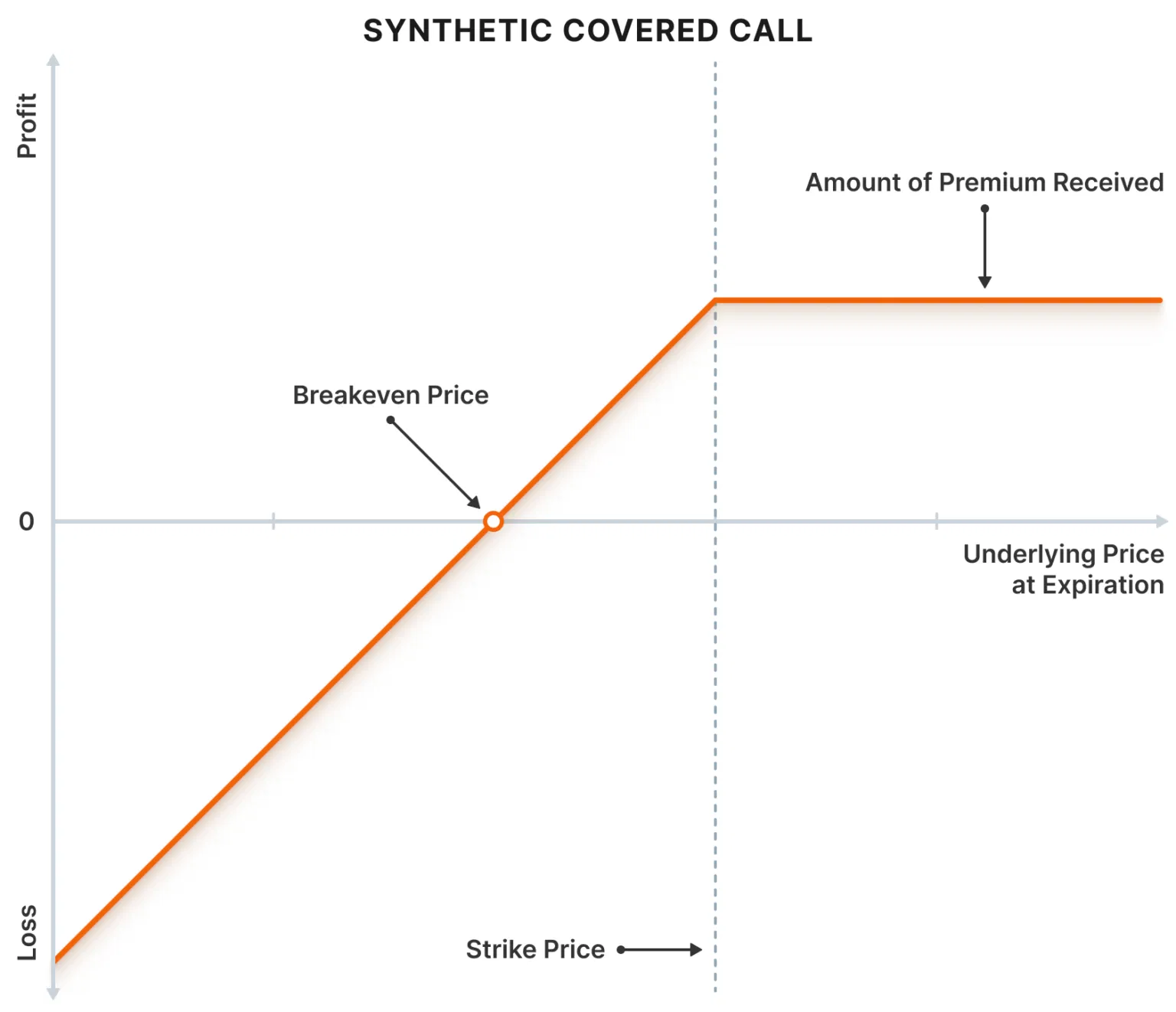
Author
Jonathan Hobbs, CFA
Date
19 Aug 2024
Category
Market Insights
Covered Call Strategy Explained
Your capital is at risk if you invest. You could lose all your investment. Please see the full risk warning here.

What is a covered call?
A covered call is an options strategy where an investor holds a long position in an asset such as stocks, ETFs or commodities, and sells call options on that same asset. In return for the sale of the call options the investor receives a premium. The underlying asset can either be owned in advance or purchased when implement the covered call.
A covered call gives the call options buyer the right to purchase the underlying asset from the call option seller at a specified price (strike price) and at any time on or before a specified date (expiration date).
The strategy is considered “covered” because the option seller already owns the underlying asset, mitigating the risk of having to purchase the asset at a higher market price to fulfil its obligation if the call option is exercised.
Key components of a covered call include:
Long Position in the Asset: The investor owns the underlying asset.
Selling Call Options Against the Asset: This generates income through the premiums received from selling the call option, while also providing some downside protection.
The covered call is one of the most popular strategies among investors enabling the option sellers to generate additional income from their portfolios or to provide them with a downside protection against potential future declines in the price of the underlying. The potential losses are limited to the downside movement in the underlying asset’s price, less the premium received from writing the call option.
A covered call is also considered a type of hedging strategy where the investor sacrifices some potential upside of the stock for a certain period in exchange for the option premium.
When to Use a Covered Call?
The covered call strategy is ideal for investors who are neutral to moderately bullish on a certain asset and are intending to hold it for an extended period of time. Writing calls over these assets helps investors generate additional income and lowers the cost basis of the original position.
Setting Up a Covered Call
A covered call is a relatively easy position to establish.
Firstly, the investor needs to select an underlying asset to buy which is willing to hold for the duration of the options contract or longer.
Once the underlying asset is bought then the investor can select the call option to sell. Typically, 1 call option could be sold for every 100 shares of the underlying. The key consideration when choosing the call option are the strike price and the expiry date.
The strike price is usually above the current market price (out-of-the-money) and is a level at which the investor is comfortable to sell the underlying.
The closer the current underlying price is to the strike price of the call option, the higher the premium will be. This is because the probability of the covered call becoming in-the-money (where the strike price is lower than the underlying price) and being exercised at expiration increases.
The expiration date is based on the investor’s time horizon and market outlook. Expiration dates can range from one week to several months out. The further out is the expiration date, the higher the premium for the option, as it has more time to become in-the-money.
Exiting a Covered Call
At expiration of the call option there are several scenarios for exiting a covered call, depending on where the underlying price is relative to the strike price of the call option.
If the underlying price has declined and has remains below the call’s strike price, the option will expire worthless, and the call writer would retain the underlying and keep the premium received from selling the call. Such a call option is said to be out-of-the-money.
If the underlying price rises above the call’s strike price such a call option is said to be in-the-money. In such situation the call option seller needs to decide whether it wishes to sell the underlying or not. If the covered call writer does not want to be exercised, the call option can be rolled out to the next expiration period and potentially at a different strike price.If the call is not rolled over, the option would be exercised by the option buyer and the covered call writer has to sell its shares at the strike price. In this case the call option seller keeps the premium received and the gains from the rise of the underlying up to the strike price. Any movement above the strike price is forfeit.
If the underlying price has moved sideways and is the same as the strike price, such an option is said to be at-the-money. At-the-money options are rarely exercised by the buyer of the call; therefore, the call writer has a good probability of retaining the underlying asset and keep the premium.
The covered call can be re-established once the call option lapses. If the call option is out-of-the-money and expires worthless the investor can simply sell another call. If the call is in-the-money and the underlying asset is called away, the investor can easily set up the covered call again by purchasing the underling and selling a new call option.
The Effect of Time Decay on a Covered Call
The time remaining to expiration is one of the key factors determining an option’s extrinsic value, which influences the option’s premium price. All things being equal, short call options with longer time to expiration are priced higher compared to those with shorter durations. This is because a longer time frame increases the potential of a larger price movement in the underlying, increasing the likelihood that the call option will become in-the-money and be exercised at expiration.
As the expiration date approaches, the value of the call option typically decreases. This decline, known as time decay or theta, benefits the covered call writer and works against the option buyer.
The Effect of Implied Volatility on a Covered Call
Implied volatility represents the market’s expectations of future price movements in the underlying asset and plays a significant role in determining the value of an option. Higher implied volatility indicates an anticipation of larger price swings and typically leads to higher option premiums. Selling covered calls when implied volatility is high is more advantageous as it results in a higher premium. The premium is higher in order to compensate the option seller for the higher probability that the call option might be exercised.
Example of Covered Call Strategy on NVIDIA (NVDA)
1. Stock Position:
Investor buys 100 shares of NVIDIA at $110 per share.
Total investment in NVIDIA stock: 100 shares * $110 = $11,000.
2. Call Option Selection:
The investor chooses an out-of-the-money call option with a strike price of $115 expiring in one week.
Premium received for selling the call option is $2.00 per share.
Since each option contract typically represents 100 shares, the total premium received is: 100 shares * $2.00 = $200.
3. Net Investment Required:
Purchase of NVIDIA shares minus premium received: $11,000 – $200 = $10,800.
4. Potential Outcomes:
Scenario 1: At expiration NVIDIA share price rises to $113, but is below the strike of $115:
The call option expires worthless.
The investor keeps the $200 premium.
The investor still owns the 100 NVIDIA shares which are now worth $11,300 (100 NVIDIA shares * $113).
Total proceeds from the strategy (current value of shares + premium received): 100 NVIDIA shares * $113 = $11,300 + $200 = $11,500.
Total profit from the strategy (current value of shares – purchase price of shares + premium received): $11,300 – $11,000 + $200 = $500.
Scenario 2: At expiration NVIDIA share price rises to $117, above the strike of $115 :
The call option is exercised by the option buyer.
The investor sells 100 NVIDIA shares at the strike price of $115: 100 * $115 = $11,500.
Total proceeds from the strategy (sale price of shares + premium received): $11,500 + $200 = $11,700.
Total profit from the strategy (sale price of shares – purchase price of shares + premium received): $11,500 – $11,000 + $200 = $700 /li>
Scenario 3: At expiration NVIDIA share price declines to $108, below the strike price of $115:
The call option expires worthless
The investor keeps the $200 premium.
The value of the 100 NVIDIA shares has declined to $$10,800: 100 shares * $108 = $10,800.
Total proceeds from the strategy (current value of shares + premium received): $10,800 + $200 = $11,000.
Total profit from the strategy (current value of shares – purchase price of shares + premium received): $10,800 – $11,000 + $200 = $0.
Summary of the Strategy:
Initial Investment: $11,000 (100 shares of NVDA at $110 each)
Premium Received: $200 (for selling one call option with a strike price of $115)
Breakeven Price: $110 (initial stock price) – $2 (premium received per share) = $108
Max Profit: $700 if NVDA stock price is at or above $115 at expiration.
Potential Loss: Purchase price – Current price + Premium received.
FIGURE 1: Covered Call Payoff Diagram:

In this example the covered call strategy provides some income (the premium) and caps the upside potential at the strike price plus the premium received. It also offers a slight cushion against a downside move in the stock price, lowering the breakeven point to $108.
Covered Call vs. Synthetic Covered Call
The concept of synthetic options trading strategies is quite straightforward. These strategies are designed to replicate the profit and loss profile of another strategy but constructed using different components. Typically, the strategy being replicated will involve the use of multiple options positions.
How to Construct a Synthetic Covered Call?
There are several ways to create a synthetic covered call which replicates a traditional covered call by using options alone, while achieving the same payoff characteristics:
Using a single option: The first and most simple way to replicate a traditional covered call strategy is by selling at-the-money put options.
Using a combination of options: The second way to create a synthetic covered call is by replacing the long asset position with deep-in-the-money with a further-out expiry call options. These options mimic the profit potential of holding the actual stock but require significantly less capital. Then the investor sells short-term out-of-the-money call options against the long call position with closer expiry. This generates income and helps to reduce the overall cost basis of the trade.
The synthetic covered call requires significantly less capital, as the need to buy the underlying asset is eliminated. In essence, the strategy allows investors to benefit from the same potential gains and income as a traditional covered call strategy and is particularly advantageous for investors with a neutral to bullish outlook on the market.
Example of Synthetic Covered Call Strategy on NVIDIA (NVDA)
Let’s now transition from the previous example of a traditional covered call to a synthetic covered call. We will keep NVIDIA shares as underlying. Again, NVIDIA shares are trading at $110, but instead of buying the shares outright the investor decides to buy deep in-the-money call options expiring in 6 months in order to gain exposure to the underlying. For instance, the investor chooses to buy one NVIDIA call option with a strike price of $60 for a premium of $50 for the first leg of the synthetic covered call strategy. Then the investor sells one NVIDIA call with $115 strike price, expiring in one week for a premium of $2. It is clear that the synthetic covered call requires significantly lower initial capital outlay than the traditional covered call.
1. Purchase of Deep-In-The-Money Call Option with Longer Expiration:
The investor buys 1 NVIDIA call option with a strike price of $60.
Premium paid for buying the call option is $50 per share.
Total cost for the long call option: Since each option contract typically represents 100 shares, the total premium paid is: 100 shares * $50.00 = $5,000.
2. Sale of Out-Of-The-Money Call Option with Closer Expiration:
The investor sells an out-of-the-money call option with a strike price of $115 expiring in one week.
Premium received for selling the call option is $2.00 per share.
Total premium received: Since each option contract typically represents 100 shares, the total premium received is: 100 shares * $2.00 = $200.
3. Effective Cost Bais:
Cost of long NVIDIA call option minus premium received: $5,000 – $200 = $4,800.
The two examples illustrate that the synthetic covered call could reduce with more than 50% the initial capital outlay required for the traditional strategy. In the first example we showed the net investment required for the traditional covered call is $10,800 vs. $4,800 for the synthetic version.
4. Profit and Loss:
The profit and loss profile of this synthetic setup mirrors the classical covered call.
FIGURE 2: Synthetic Covered Call Payoff Diagram

Conclusion:
A covered call strategy is an effective way for investors to generate additional income and provide some downside protection on stocks they own. However, it requires careful selection of strike prices and expirations, along with an understanding of the potential risks, particularly the capped upside and the obligation to sell the underlying shares if the option is exercised. This strategy is best suited for moderately bullish or neutral market conditions where the investor does not expect significant increases in the stock price.
Your capital is at risk if you invest. You could lose all your investment. Please see the full risk warning here.
Related Products:
Strategy
Cash-Secured Put + Equity
Distribution Yield
66.79%
Strategy
Cash-Secured Put + Equity
Distribution Yield
43.80%
Strategy
Covered Call
Distribution Yield
11.78%
